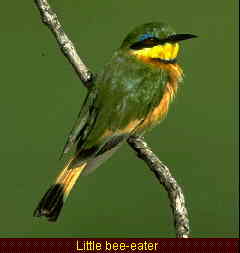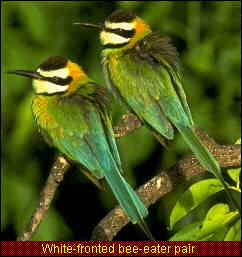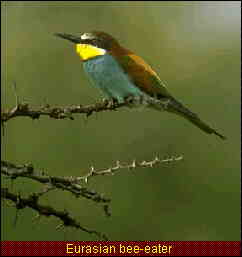


|
Family - Meropidae
Identification - Small to medium-sized birds with brilliantly colored plumage and a black stripe through the eye. Long, slender, slightly down-curved, pointed bills. Long, sharply pointed wings. In some species the tail feathers are noticeably elongated. Sexes similar. Immatures are duller versions of adults but without elongated tail feathers.
Voice - Certain species are quite vocal; liquid trills and short, sharp, chirrup-like notes, "kroop" or "kwip", repeated.
Habitat - Woodlands, riverine thickets, thorn bush and savanna.
Habits - Many species are gregarious. The little bee-eater is usually solitary or in pairs during the daytime, though a number of individuals may roost together on a branch during the night. The Eurasian bee-eater is a non-breeding Palaearctic winter visitor to East Africa. Some of the other species are non-breeding intra-African migrants, while the others are residents that breed here. Bee-eaters fly in a graceful, swallow-like manner, exhibiting tremendous acceleration to capture insects on the wing. They repeatedly return to perch on a branch or wire where they stun their prey with a series of rapid blows before swallowing it. Most species breed and roost colonially.
Food - Insects; particularly bees, wasps, and hornets; also butterflies, dragonflies and winged termites (alates).
Nest - A burrow excavated in the ground or in banks, terminating in an unlined nest chamber.
|





